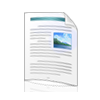Temps des images (Le)
- Auteur : Melot, Michel
- Résumé en allemand : Bild und Text stellen seit langer Zeit zwei gegensätzliche Kategorien dar, die die Medienlandschaft nach der von Horaz Kunst der Poesie übernommenen These unter sich aufgeteilt haben: Ut pictura poesis. Diese klassische Vorschrift zur Wissensvermittlung ist heutzutage ins Wanken geraten. Die Tonaufzeichnung, durch die eine mündliche Überlieferung gegenüber der Schrift rehabilitiert wurde, hat die Welt des Textes gespalten. Die Schrift hat, dank der modernen Reproduktionsmittel (Lithografie, Fotografie, Fotokopie, Digitalisierung), mittlerweile Geschriebenes an die Seite von Bildern gesetzt. Die Welt der Bilder ist zweigeteilt in statische, stumme Bilder und animierte Bilder, die an eine Erzählung gebunden sind. Schliesslich scheint die Bindung an die Sprache das unterscheidende Element zu sein und reaktivert damit die alten Gegenpole Lessings zwischen der Kunst der Zeit und der Kunst des Raums. In diesem neuen Umfeld, in dem das Buch Konkurrenz von der (Internet-) "Site" erhält, scheint es seinen Wert mehr der symbolischen Wirksamkeit seiner Stofflichkeit zu verdanken als der Besonderheit seines Inhalts.
- Résumé en anglais : Text and images have for long constituted two paradoxical categories which share in the setting up of the media, in a doctrine inherited from the poetic art of Horace: Ut pictura poesis. This classical order of the resources of knowledge is reversed today. Sound recordings, by rehabilitating orality in relation to the written word, have divided the world of text. Writing during this time, thanks to modern means of reproduction (lithography, photography, photocopying, digitisation), has moved from the written word towards the image. The world of the image has been split in two: the still, silent image and the moving image, tied to a narrative. In the last instance, it is the link to language that seems to differentiate these media, and that revives the old opposition of Lessing between the arts of time and the arts of space. The book, in this new situation, has come up against the "site", and seems to owe its value more to the symbolic virtues of its materiality rather than to the uniqueness of its content.
- Résumé en espagnol : El texto y la imagen han constituido durante largo tiempo dos categorías antinómicas, que se compartían la constitución de los medias, en una doctrina heredada del arte poético de Horacio: Ut pictura poesis. Este orden clásico de los medios de conocimiento está hoy día trastornado. La grabación sonora, al rehabilitar la oralidad en relación a lo escrito, ha escindido el mundo del texto. La escritura, mientras tanto, gracias a los medios de reproducción modernos (litografía, fotografía, fotocopia, numerización), ha hecho pasar lo escrito del lado de la imagen. El mundo de la imagen ha sido cortado en dos: la imagen fija y muda, la imagen animada ligada a un relato. En última instancia, es el lazo con la lengua que parece ser el discriminante de estos medias, y reactiva la vieja oposición de Lessing entre las artes del tiempo y del espacio. El libro, en su nuevo paisaje, en competencia con el "sitio", parece deber su valor más a las virtudes simbólicas de su materialidad que a la especificidad de sus contenidos.
- Résumé : Le texte et l'image ont longtemps constitué deux catégories antinomiques, qui se partageaient la constitution des médias, dans une doctrine héritée de l'Art poétique d'Horace : Ut pictura poesis. Cet ordre classique des moyens de connaissance est aujourd'hui bouleversé. L'enregistrement sonore, en réhabilitant l'oralité par rapport à l'écrit, a scindé le monde du texte. L'écriture, pendant ce temps, grâce aux moyens de reproduction modernes (lithographie, photographie, photocopie, numérisation), a fait passer l'écrit du côté de l'image. Le monde de l'image a été coupé en deux : l'image fixe et muette, l'image animée liée à un récit. En dernière instance, c'est le lien à la langue qui semble être le discriminant de ces médias, et réactive la vieille opposition de Lessing entre les arts du temps et les arts de l'espace. Le livre, dans ce nouveau paysage, concurrencé par le « site », semble devoir sa valeur plus aux vertus symboliques de sa matérialité qu'à la spécificité de ses contenus.
- Paru dans le numéro : n°5 : Images
- Licence de diffusion : Tous droits réservés
- Format : Fichier XML
- Étendue : 43091
- Date de publication : 2001
- Langue : fr
- Sujet(s) : image
- Type de ressource : Text
Ce document est également disponible dans le format suivant :

